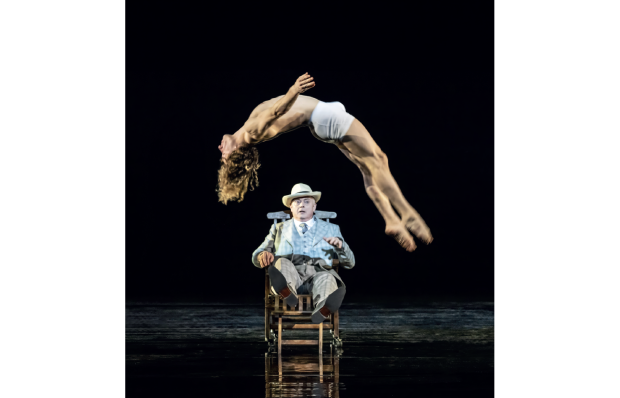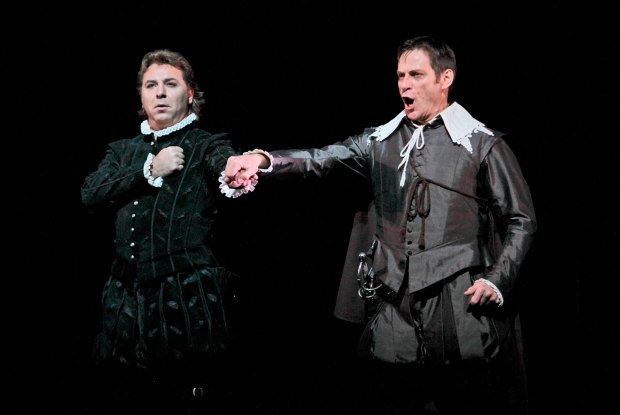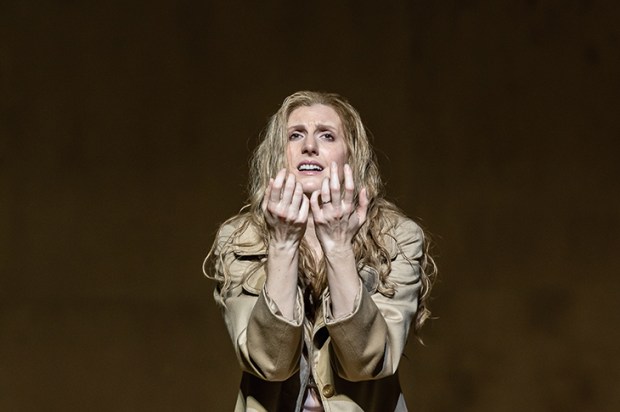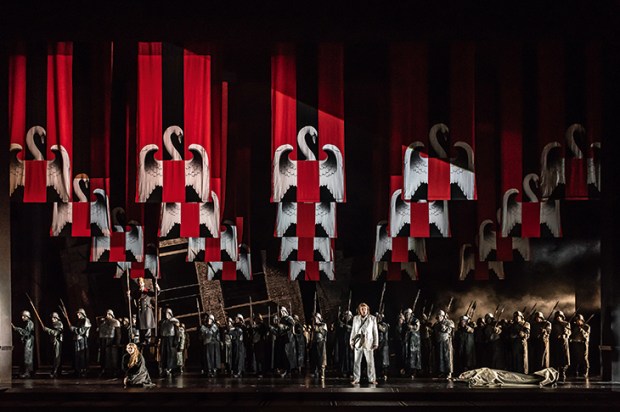The many opera performances at the Proms this year have all been so successful, especially the Wagner series, that I hope it doesn’t require a centenary to include them in future seasons. One of the things that has made them so vivid to the audiences in the Albert Hall has been the immediacy of the contact between singers and public, despite the hall’s vast spaces. It would be nice, but vain, to think that the present breed of directors, with their concepts and conceits, might learn that the simpler the productions they mount, the more their audiences are likely to respond to the works; but the tendency in opera houses is to regard the opera as written by the librettist and composer as mere raw material to be twisted into any shape that might make it relevant and shocking. All the more reason why concert or semi-staged performances should become more frequent.
Glyndebourne’s production of Britten’s Billy Budd was so powerful that there was an even longer silence at the end than there was at Götterdämmerung, though that might be partly accounted for by the way the piece just drifts into silence, the libretto ending with three dots rather than a full stop, as we assume that Captain Vere’s musings on how Billy has saved him and he’s content will continue for some time after the curtain falls.
Andrew Davis, the superb conductor, said in the interval on the radio that of course we don’t believe for a moment that Vere is content, any more than we believe the same thing when Billy sings it. That view does make an opera that is already fraught with ambiguities tilt over into incoherence. Maybe Britten would have been happy for it to be indecipherable, since he revelled in concealment and velleity. It wouldn’t have suited E.M. Forster, though, who wanted to make things plainer than Britten did, and was disappointed by the composer’s first attempt at setting Claggart’s Creed because it failed to express love thwarted and gone evil; and who I think would have believed in the power of Billy’s innocence to give Vere peace.
Thanks to the strong characterisation of Vere by Mark Padmore, though he sounded no older in the Prologue and Epilogue than in the body of the opera, set many years before, this bookish and speculating man came across as a more plausible captain than he normally does. And Brindley Sherratt was a wonderfully dark Claggart, whose hatred of goodness and beauty hardly needed explicit formulation. Can Britten, once a passionate Wagnerian but later fashionably contemptuous of him, have failed to realise that he was virtually reincarnating Hagen, very much as the chorus of sailors at the start of Act 2 is reminiscent of the Gibichungs in full cry? It’s interesting, too, that Britten obviously enjoyed enormously writing the belligerent music, with its fanfares and lusty cries, showing that for all his lifelong pacifism he could get excited by the sounds of male aggression.
Jacques Imbrailo was, as at Glyndebourne, a touching Billy without probing the role in the way that Christopher Maltman and Simon Keenlyside, the two finest Billys that I’ve seen, did. Maybe the part has to be fully acted. Capturing radiant innocence in music is not easy, and Billy is given his fullest chances just before his execution; and they are, for me, considerably too full. He seems, as a result of what happened with Vere in the stateroom, which we are to infer from those famous 34 chords, to have reached a kind of acceptance that a person such as we have seen him to be earlier simply could not understand. There is too much fascinating music in this opera not to want to hear it from time to time, but at its centre is a dramatic void.
Inside Wagner’s Head is the name of a one-man show at the Linbury, running for most of September. The stage is littered with props, only some of which are used — the naked manikin and a seedbed, among many other things, aren’t. Simon Callow strides in, dressed in black velvet with matt leather boots, so roughly like Wagner in his later years, and for the next hour and three quarters alternately enacts and narrates and exclaims. The aim is to instruct through entertaining, but the result is entertainment with a certain amount of information and some misinformation.
There is a huge blow-up of Arno Breker’s terrifying head of Wagner, projected on to the back curtain. The worst thing is the inclusion of tiny fragments of music, often with Callow speaking at the same time, so the chief reason for taking an interest in Wagner is relegated to what must strike any newcomer as arbitrary chords. The attempt to evoke Wagner’s oversized personality is partially successful, but would be more so if Callow would stop declaiming and whispering and just give us a few basic dates. Names are mentioned without any explanation, even when they aren’t familiar, and there isn’t much chronology.
But it means well, and the ‘cool buzzy crowd’ enticed by Deloitte into seeing it will have got some idea of why Wagner is so ‘upsetting’, to use Callow’s mot juste, a figure. And at least Stephen Fry, who is ‘curating’ the overall proceedings, didn’t intrude in this one.
Got something to add? Join the discussion and comment below.
Get 10 issues for just $10
Subscribe to The Spectator Australia today for the next 10 magazine issues, plus full online access, for just $10.
You might disagree with half of it, but you’ll enjoy reading all of it. Try your first month for free, then just $2 a week for the remainder of your first year.












Comments
Don't miss out
Join the conversation with other Spectator Australia readers. Subscribe to leave a comment.
SUBSCRIBEAlready a subscriber? Log in